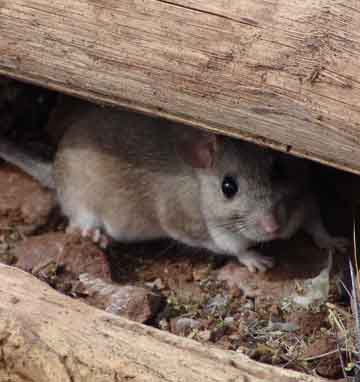 ..
..
Rodents (Order Rodentia)
Main sources: Nowak, Ronald, 1991, Walker's Mammals of the world, Fifth Edition (two vols.), Baltimore: Johns Hopkins University Press; Merlin, Pinau, "Ground Squirrels", "Pocket Gophers", "Heteromyidae", & "Muridae", in Steven Phillips and Patricia Comus, eds., 2000, A Natural History of the Sonoran Desert, pp. 496-507, Arizona-Sonora Desert Museum Press, Tucson; Burt, W. & R. Grossenheider, eds., 1976, A Field Guide to the Mammals, Peterson Field Guides: Houghton Mifflin; Cockrum, E.L., 1960, The Recent Mammals of Arizona: Their Taxonomy and Distribution, Tucson: University of Arizona Press
This order of mammals has far more members than any other group of mammals. The suborders of rodents (formerly divided into the squirrellike, ratlike, and porcupinelike suborders) are in dispute, but all rodents share certain tooth patterns: all have 4 incisors (2 above, 2 below), which grow throughout life as a segment of a true circle, and are somewhat self-sharpening; no canines or anterior premolars, hence leaving a gap between the incisors and grinding cheek teeth. [Nowak, p. 561] All rodents are gnawers -- their ever-growing teeth must be constantly trimmed by this process, which maintains a chisel-like shape to the incisors, which is unique to the rodent family [Merlin, p. 505].
Family Sciuridae (Squirrels, Chipmunks, Pairie Dogs, Marmots)
As a type, these mammals are more conspicuous than most rodents. Furry-tailed, those occupying our area have good claws for digging (4 toes on the front foot, 5 on the back) and build their nests in ground burrows. They are diurnal and feed mainly on low-growing plants, sitting on their haunches to watch for trouble. Marmots of course are limited to the northern U.S., but both Cockrum and Burt/Grossenheider show the Blacktailed Prairie Dog (Cynomys ludovicianus) as occuring along the San Pedro River somewhat to the south of our area.
Antelope Squirrel (Ammospermophilus harrisii)
Rock Squirrel (Spermophilus variegatus)
.........................................................
Family Castoridae (Beavers)
Among rodents, Beavers (Genus Castor) are most closely related to the squirrels, but they are primarily aquatic, builders of dams, canals, and pond-lodges along streams. They work nocturnally, cutting down deciduous trees with their large incisor teeth, eating the twigs, bark, and leaves as their primary diet and using the trunks and branches to build their artificial-pond homes.
Only two species of the Genus Castor (sole extant genus of the family) survive, one in Europe and one in North America. Once plentiful the full length of the San Pedro River, the American Beaver was entirely eliminated from this valley by trappers during the 19th century, and was only reintroduced to the Upper San Pedro late in the 20th century. They are now spreading into the Middle San Pedro, and we are monitoring their progress.
American Beaver (Castor canadensis)
.........................................................
Family Geomyidae (Pocket Gophers)
Pocket gophers have short legs, stout, thickset bodies with little evidence of a neck, nearly naked tails (always shorter than head and body), small eyes and ears, reach about 91/2 inches in length and weigh up to half a pound. Their large incisor teeth are always exposed. They occupy locations where soils are easily dug, so are found mainly in our floodplains, where their fan-shaped mounds of earth reveal their presence. They eat a wide range of vegetable foods (storing food in external, fur-lined cheek pouches), and are rarely seen but remain inside their extensive tunnel systems (which include storage, latrine, and nesting chambers). They are mainly solitary creatures. Merlin (p. 496) lists 3 species for the Sonoran Desert.
Western Pocket Gopher (Thomomys bottae)
.........................................................
Family Heteromyidae (Pocket Mice & Kangaroo Rats)
Neither rats nor mice, these rodents are all nocturnal, burrowing animals, mostly small but exhibit considerable variation in appearance. Their front feet are weak, while hind legs are well developed. Like the pocket gophers, they have external fur-lined cheek pouches, which they use for storing seeds (their primary food). They also build extensive tunnel systems with specialized chambers, and the systems often have several openings. Most species never need to drink water. A variety of species of Heteromyids are present in our Sonoran Desert, each specializing in distinctive foraging strategies (thus minimizing intrafamily competition). Among these, members of the genus Dipodomys (Kangaroo Rats) have large heads, big eyes, long tails, and large hind feet; they are bipedal and can jump up to 9 feet in one bound, a useful ability for escaping predators. They forage fairly widely. Members of the genera Perognathus and Chaedodipus (the Pocket Mice) are quadrupeds, somewhat smaller than Kangaroo Rats, and forage less widely in range. Merlin (p. 501) lists 10 species for the Sonoran Desert.
.........................................................
Family Muridae (Mice & Rats)
By far the largest mammalian Family, the mice and rats are natives nearly worldwide, and they vary greatly in form (from 100 mm [4"] to 800+ mm (31"] long, for example) and in function (diurnal vs nocturnal, terrestrial/arboreal/semiaquatic, etc.). Our Sonoran Desert boasts them in great number and variety -- from "predatory grasshopper mice that hunt and kill other mice" to Cotton Rats that "eat mostly green plants and grasses", from those who sleep in burrows among rocks to "packrat builders that construct houses of sticks and debris up to 2 or 3 feet (1 m) high and 8 feet (2.4m) wide" (Merlin, p. 505-7). All Muridae are heavily preyed upon by our desert carnivores, but like the Cottontail Rabbits they breed prolifically in compensation. Merlin (p. 505) lists 7 species for the Sonoran Desert.
Packrat or White-throated Woodrat (Neotoma albigula)
Back to Mammals